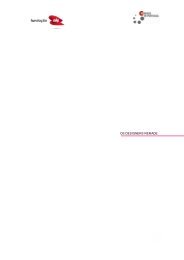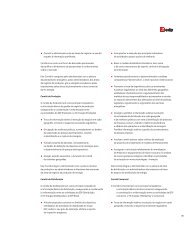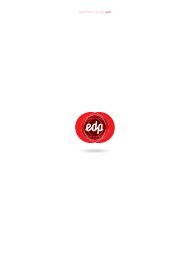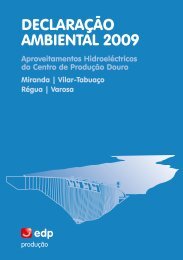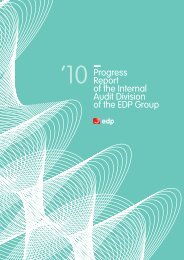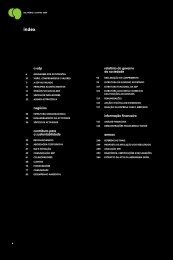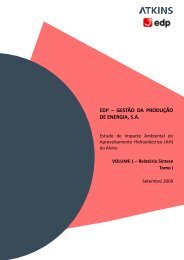Annual Report - EDP
Annual Report - EDP
Annual Report - EDP
- No tags were found...
Create successful ePaper yourself
Turn your PDF publications into a flip-book with our unique Google optimized e-Paper software.
notes to the consolidated <strong>EDP</strong> and - Energias company de Portugal, financial S.A. statementsfor the Notes years to the ended Consolidated 31 december and Company 2012 Financial and Statements 2011for the years ended 31 December 2012 and 2011b) Basis of consolidationThe accompanying consolidated financial statements reflect the assets, liabilities and results of <strong>EDP</strong>, S.A. and its subsidiaries (Group or <strong>EDP</strong> Group) and the equity andresults attributable to the Group, through the investments in associates.As from 1 January 2010 onwards, the <strong>EDP</strong> Group applied IFRS 3 (revised) for the accounting of business combinations. The changes in accounting policies resultingfrom the application of IFRS 3 (revised) are applied prospectively.SubsidiariesInvestments in subsidiaries where the <strong>EDP</strong> Group has control are fully consolidated from the date the Group assumes control over their financial and operatingactivities until the moment that control ceases to exist. Control is presumed to exist when the Group owns more than half of the voting rights. Control also exists whenthe Group has the power, directly or indirectly, to manage the financial and operating policies of the entity to obtain benefits from its activities, even if the percentage ofshareholding is less than 50%.Until 31 December 2009, when the accumulated losses of a subsidiary attributable to non-controlling interests exceed the non-controlling interests in its equity, theexcess was attributed to the Group and charged to the income statement as incurred. Profits subsequently reported by the subsidiary were recognised as profits ofthe Group until the losses attributable to the non-controlling interests previously recognised by the Group have been recovered. As from 1 January, 2010, the dueproportion of accumulated losses are attributed to non-controlling interests, implying that the Group can recognise negative non-controlling interests.As from 1 January 2010, on a step acquisition process resulting in the acquisition of control the revaluation of any participation previously acquired is booked againstthe profit and loss account when goodwill is calculated. On a partial disposal resulting in loss of control over a subsidiary, any participation retained is revalued atmarket value on the sale date and the gain or loss resulting from this revaluation is booked against the income statement.AssociatesInvestments in associates are accounted for by the equity method from the date the Group acquires significant influence to the date it ceases. Associates are entitiesover which the Group has significant influence, but not control, over its financial and operating policies. Generally, when the Group holds more than 20% of the votingrights of the investee it is presumed to have significant influence. If the Group holds, directly or indirectly, less than 20% of the voting rights of the investee, it ispresumed not to have significant influence, unless such influence can be clearly demonstrated.The existence of significant influence by the Group is usually evidenced by one or more of the following:- Representation on the Executive Board of Directors or equivalent governing body of the investee;- Participation in policy-making processes, including participation in decisions about dividends and other distributions;- Existence of material transactions between the Group and the investee;- Interchange of managerial personnel;- Provision of essential technical information.The consolidated financial statements include the Group's attributable share of total reserves and profits or losses of associates, accounted for under the equitymethod. When the Group’s share of losses exceeds its interest in an associate, the Group's carrying amount is reduced to zero and recognition of further losses isdiscontinued, except to the extent that the Group has a legal or constructive obligation to cover such losses on behalf of the associate.Jointly controlled entitiesJointly controlled entities, which are consolidated under the proportionate consolidation method, are entities over which the Group has joint control defined by acontractual agreement. The consolidated financial statements include the Group's proportional share of the joint ventures' assets, liabilities, revenue and expenses,from the date the joint control begins and until it ceases.Accounting for investments in subsidiaries and associates in the company's financial statementsInvestments in subsidiaries and associates not classified as held for sale or not included in a disposal group which is classified as held for sale are accounted for atcost in the company's financial statements, and are subject to periodic impairment tests, whenever indication exists that certain financial investment may be impaired.GoodwillFollowing the transition to International Financial <strong>Report</strong>ing Standards (IFRS) on 1 January 2004 and as permitted under IFRS 1 - First-time Adoption of InternationalFinancial <strong>Report</strong>ing Standards, the <strong>EDP</strong> Group decided to maintain the goodwill resulting from business combinations that occurred prior to the transition date,calculated in accordance with the Group's previous accounting policies.Business combinations that occurred after 1 January 2004 are accounted for using the purchase method of accounting. The acquisition cost corresponds to the fairvalue determined at the acquisition date, of the assets given and liabilities incurred or assumed including the costs directly attributable to the acquisition, foracquisitions up to 31 December 2009.As from 1 January 2010 onwards, costs directly attributable to the acquisition of a subsidiary are booked directly in the income statement.As from the transition date to IFRS (1 January 2004), positive goodwill arising from acquisitions is recognised as an asset carried at acquisition cost and is not subject toamortisation. Goodwill arising on the acquisition of subsidiaries and associates is defined as the difference between the cost of acquisition and the correspondingshare of the fair value of the net assets acquired.As from 1 January 2010 onwards, the <strong>EDP</strong> Group has the possibility to book non-controlling interests at fair value or at cost, implying that the full amount of goodwillcan be booked in the financial statements, including the portion attributable to the non-controlling interests, against non-controlling interests, if the first option ischosen. Goodwill arising on the acquisition of subsidiaries and associates is defined as the difference between the cost of acquisition and the total or correspondingshare of the fair value of the net assets acquired, depending on the option taken.178A World Full Of Energy







